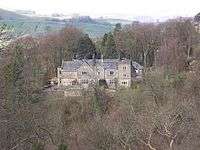River Dibb
| River Dibb | |
|---|---|
 River Dibb at Dibbles Bridge, which carries the B6265 between Pateley Bridge and Threshfield | |
| Country | England |
| Basin | |
| Main source |
Grimwith Reservoir 253 metres (830 ft) 54°4′48″N 1°54′41″W / 54.08000°N 1.91139°W |
| River mouth |
River Wharfe nr Appletreewick 143 metres (469 ft) 54°02′28″N 1°56′35″W / 54.0410°N 1.9431°WCoordinates: 54°02′28″N 1°56′35″W / 54.0410°N 1.9431°W |
| Basin size | 25.5 square kilometres (9.8 sq mi) |
| Physical characteristics | |
| Length | 5.2 kilometres (3.2 mi) |
The River Dibb is located in North Yorkshire, England. It is a tributary of the River Wharfe. Grimwith Reservoir is at the head of the River Dibb at a point some 2½ miles from Appletreewick. The name is possibly derived from the Olde English dib, a dialectical form of dip meaning hollow and recorded in local 13th century records as Dybbe, a now lost hamlet near Burnsall.[1]
Course
The river starts from the south side of Grimwith Reservoir and flows south-west through Burnett Fold Nook and then south before returning south-west to pass under the B6265 at Dibble's Bridge, which has been the scene of two coach crashes - one in 1925 when seven people were killed, and one in 1975 when 32 people were killed. Below its confluence with Holes Beck, the Ordnance Survey maps show the name of the river changing to Barben Beck.[2] It follows a mostly southerly course through Rough Close Wood and Barnscar Plantation to Rookcroft Wood. It turns west through Sprinsgide Wood and then south-west again past Hartlington Mill, where it was once used to power a 5.5 m-diameter undershot water wheel,[3][4] and under Hartlington Bridge before joining the River Wharfe.
 Hartlington Hall
Hartlington Hall
Folklore
Dibble's Bridge is sometimes referred to as Devil's Bridge. It is traditionally said to have been built by the Devil for a shoemaker named Ralph Calvert, after Calvert offered the Devil a drink.[5]
Lists
Tributaries
|
Settlements
|
Crossings
|
References
- ↑ "Etymology". Retrieved 13 October 2011.
- ↑ Online Map showing the change of name to Barben Beck
- ↑ "Hartlington Mill, Hartlington". Retrieved 29 February 2012.
- ↑ David Johnson. "Hartlington Kiln 2010 Excavation Report" (PDF). Retrieved 4 March 2012.
- ↑ Ash, Russell (1973). Folklore, Myths and Legends of Britain. Reader's Digest Association Limited. p. 353. ISBN 9780340165973.